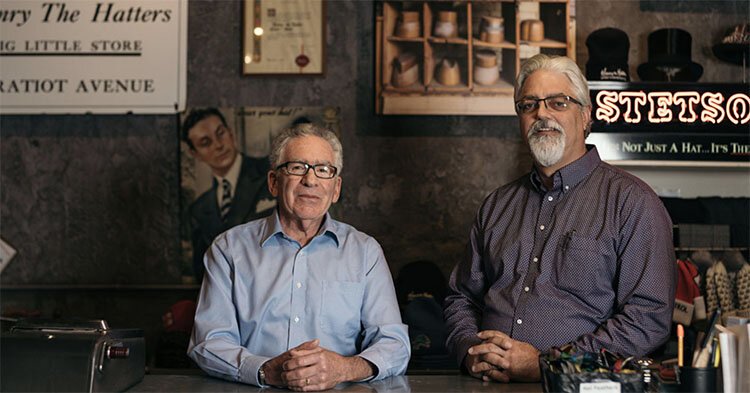In Good Co.: How the next generation of Henry the Hatter, and the reign of Henry V, was born
Henry the Hatter has helped Detroiters sustain their swagger over the decades, through good times and bad. But just a few years ago, that legacy was threatened.

This story was originally published on In Good Co. Watch the video here and listen to the podcast here.
A hat is not just about fashion. It’s a statement of your personal brand, of making an impression while strolling down the sidewalk, of letting people know that you know how to present your best self to the world.
And for the past 127 years, there has been no better place to find a quality, Detroit-style hat than Henry the Hatter.
“If you go to any other city and you see somebody with a hat on, they will say, that guy’s from Detroit. Well, how can you tell? Look at his hat, look at his shoes… Just the way he’s dressed. There is a sort of Detroit swagger,” says Joe Renkiewicz, the Hatter’s current owner who’s affectionately known as Henry V, a title representing the passing of the hat from owner to owner and a divine rite of succession from the store’s first owner, Henry Komrofsky, who founded the business in 1893.
Henry the Hatter has helped Detroiters sustain their swagger over the decades, through good times and bad. And not just Detroiters. The Hatter has outfitted the likes of Steve Harvey, LL Cool J, the notorious Purple Gang, Jimmy Kimmel, and President Dwight Eisenhower, who wore a hat from the shop at his second inauguration in 1957.
But just a few years ago, that legacy was threatened when Renkiewicz’s longtime boss and mentor Paul Wasserman, Henry IV, lost the lease to the Hatter’s downtown location on Broadway. Without a home, Wasserman was about ready to throw in his figurative hat, close the flagship Detroit location, and sell his Southfield location to his protege.
Renkiewicz had something else in mind. What he realized is that if the legendary shop cut off its deeply rooted connection to Detroit, a piece of the city’s identity would also be lost.
So Wasserman and Renkiewicz sat down and came up with a plan. It was agreed that Renkiewicz would ease into ownership, but only if that meant he could find another home for the Hatter in Detroit.
And with that, the next generation of Henry the Hatter, and the reign of Henry V, was born.
“I made my progression, and what Joe will do in the next 30, 40 years hopefully is going to be this,” Wasserman said in an interview, inside the Hatter’s newest home on Riopelle Street in Eastern Market.
This gradual succession follows a long line of apprentices in the Hatter family, starting with the original owner, Henry Komrofsky, who opened the store’s first location in 1893 on Gratiot Avenue downtown. In 1904, he hired a stock and delivery boy, Gustave Newman, who would eventually go on to be a partner in the business.
As Wasserman tells it, his father Seymour Wasserman, Henry III, came into the picture in 1948 after Komrofsky’s widow and Newman continued running the shop for several years after the founder’s passing. The Wassermans were originally from Brooklyn and Paul’s father, who ran a hat shop there, learned that Henry the Hatter was for sale in Detroit.
So he hopped on a train and got off at the Michigan Central Station to check out the space. He and business partner Murray Appleby purchased it on the spot, and Wasserman relocated his family, including Paul, who was still a small boy, to the Motor City. A few years later, Wasserman bought out his partner.
The hat business was always in the cards for the younger Wasserman, who started out in the shop’s factory as a teen making 75 cents an hour. While his buddies were planning to cruise around in their cars all summer, he followed his father’s direction and started working.
The changing of the hands of the business between father and son came naturally over the years and was only official when the elder Wasserman died in 1998. By then, Paul had learned everything he needed to know to run the business.
“You never know when you’re going to go from becoming the student to the teacher, you know, it’s just very, very gradual,” says Wasserman.
The same could be said for Renkiewicz.
Like Wasserman, Renkiewicz started with the company in high school when Henry the Hatter opened up in Hamtramck in 1985. Wasserman’s father called a counselor from Hamtramck High School looking for kids to help staff the new shop, and that’s when Renkiewicz’s name came up.
Ironically, Renkiewicz’s love for hats came when he was about six years old when he was photographed proudly wearing one with a suit for Easter.
By the time the Hamtramck location was set to open, Renkiewicz had already graduated from high school. He had initially gone into the printing business, which he found to be a bit too monotonous for him. A few semesters of college, no, that wasn’t for him either.
He spent a few years working at a mom-and-pop grocery store in Poletown where he realized his love of interacting with people on a day-to-day basis. He eventually got married, took another job at a bakery and that’s when his old high school principal walked in and mentioned a job opening at the new Henry the Hatter’s location.
Finally, a job that could support his new family, working with customers every day. Oh, and it would involve that love of hats.
All these years later when talking to Renkiewicz, you can tell that he probably knows more about hats than just about anyone in the city. When a customer walks into the shop and insists on purchasing a hat they saw some celebrity wearing on TV, he’s able to take a look at the shape of their face and bone structures and steer them to something that will be more flattering.
Same goes for his knowledge of quality.
“I can put four or five hats on the table here and they’re going to look exactly the same. Until you actually feel them and look at the quality of materials that they’re made of – whether it’s standard wool with a cotton sweatband or a better quality wool with a leather sweatband—you can’t really tell the difference,” says Renkiewicz. “Once you realize that one hat costs $30 compared to another one that costs $300, it’s not only the feel, but you can see the difference in the materials.”
It’s that kind of sage hat wisdom that makes Renkiewicz a natural fit for stepping in.
It’s also what sets the Hatter apart from the number of new retailers coming into the greater downtown area. After departing the Broadway location, the shop found a new home in Eastern Market in late 2017, a shopping district that’s contending with balancing the character of the old neighborhood with the new.
Situated in a former meatpacking plant, the new Hatter’s location most recently was home to a fancy pet store, where folks could come in and buy little outfits and locally-baked treats for their dogs. Next door, the Detroit City Distillery, a hip, low-lit bar which when it opened in 2014, became one of the first new spirit-makers to enter the city since Prohibition.
A couple of blocks away, the market’s beloved Russell Street Deli closed last year after its landlord hiked up the rent, amid an outcry from fans who accused the landlord of pushing out good stewards of the neighborhood.
Meanwhile, in downtown, several national retailers like Nike, Madewell, and notably H&M have made their way into the Motor City.
Wasserman doesn’t seem too fazed by these new developments. Sure, some of the retail landscape will go on to thrive, like the many internet-based companies that have disrupted the traditional department store models. Others, he says, will be long forgotten in 20 years.
“What I don’t like to see are the cookie-cutter stores, where you could be blindfolded and dropped in any city and not know where you were,” says Wasserman. “It’s just nice to mix the old and the new.”
Besides, he says, there will always be a niche for shops like the Hatter that cater to an audience that wants that hands-on touch—where generations of Henrys can stand side by side and give their customers a unique experience.
Developed by the New Economy Initiative (NEI), with support from the Knight Foundation, In Good Co. is a living platform, connecting inspirational stories with practical tools to empower entrepreneurs at every age and every stage of business.





